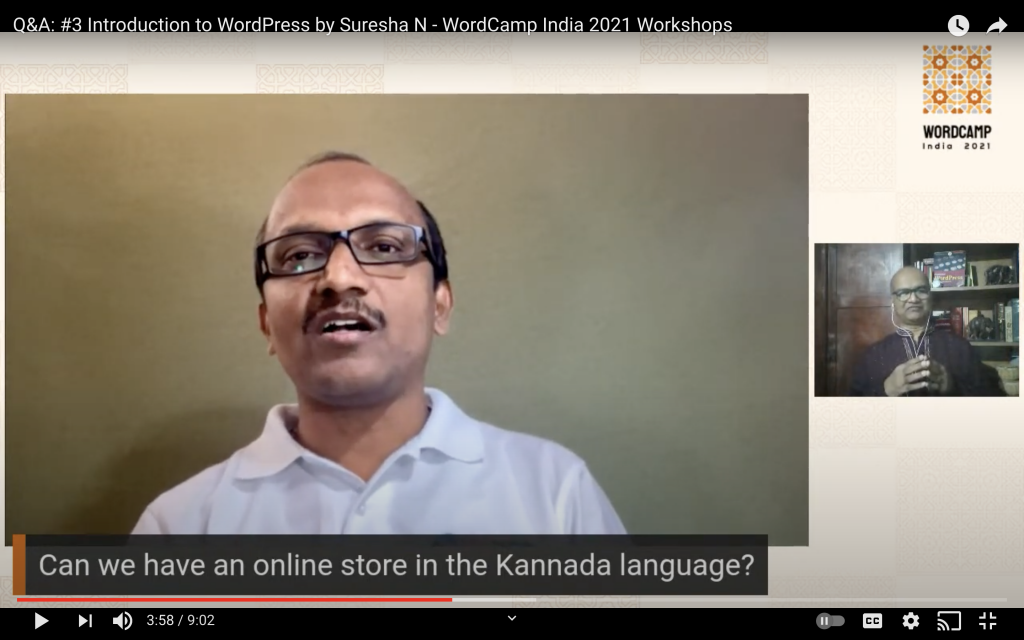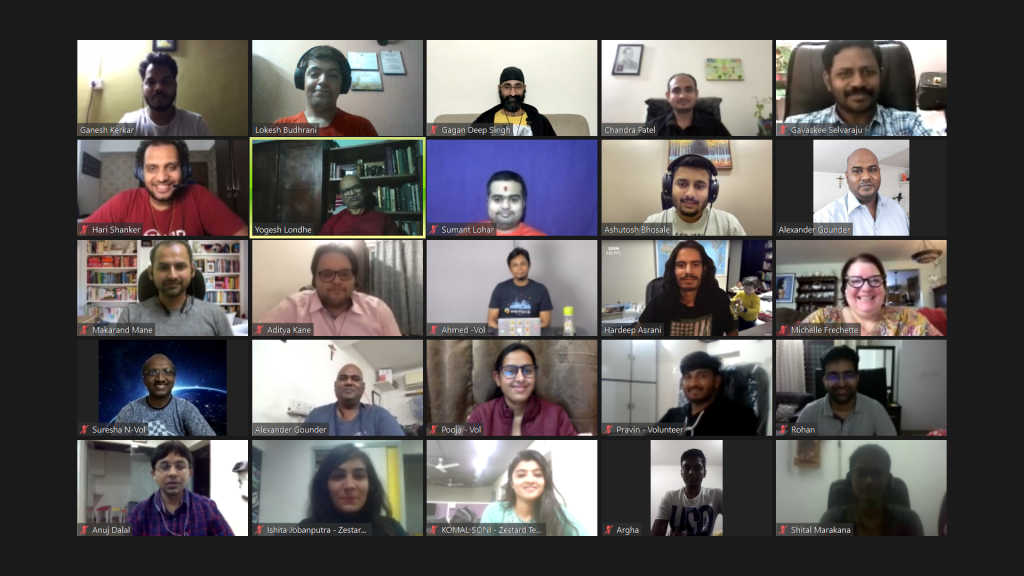WordCamp India 2021 (Online) was held across three weekends. The event kicked off on January 30th and wrapped up on February 14th. Looking back, organizing the event was a one-of-a-kind experience, and as members of the organizing team, we would like to share our experience.
WordCamp India has some history – the first edition of the event was held in 2009, but back then, the WordPress Community in India was in a nascent stage. Ever since, the community has grown, and now we have several active meetup groups and local WordCamps. The idea of a full-fledged WordCamp India has always been the dream of all Indian community organizers. In 2020, as the COVID-19 Pandemic hit us hard, WordPress events moved online and regional online WordCamps were encouraged. As a result, WordCamp India got a new lease of life – former WordCamp Mumbai organizer – Alexander Gounder, kicked-off the efforts by sending in an application, and soon WordCamp India was born.
Inspired by the Community team blog post on reimagining online events, and excited about the announcement of the Learn WordPress initiative – we decided to shake things up a bit. Our co-organizer Aditya Kane came up with the idea of a three-weekend WordCamp. We would have Multilingual WordPress workshops for beginners on week 1, our contributor event on week 2, and finally our sessions on week 3. We kicked-off with a plan to hold the event around November-December 2020. Within no time, our design team burned the midnight oil and released the WordCamp India logo and the design language.
It was ambitious and exciting! However, we underestimated the impact of the COVID-19 pandemic and its effects on our organizing team. Many members of our organizing team had to step back due to personal challenges, which were exacerbated by the global pandemic. With a mounting number of tasks associated with a regional WordCamp and a dwindling organizing team, we decided to postpone the event to January – February 2021. After a lot of groundwork, by late November 2020, WordCamp India found a place in the WordCamp Central schedule, with dates of January 30-31 (workshops), February 6-7 (contributor day), and February 13-14 (Sessions).
The months of December 2020 – January 2021 saw the organizing team on overdrive to make the event happen. Even as we continued to lose organizers, we found support in the form of enthusiastic volunteers who stepped in. We also pivoted from a plan to do video production on our own, to hire an external vendor to help us with pre-production, stitching, and some post-production work – which significantly helped us.
As a result, we successfully kicked off our WordCamp with Introduction to WordPress workshops on January 30-31. The event was spread out across two tracks on each day. These workshops were on basic WordPress topics, such as Introduction to WordPress, Block Editor basics, site hosting basics, and Introduction to WooCommerce. The highlight was that we had these workshops delivered in several Indian languages – Gujarati, Kannada, Marathi, Malayalam, and Tamil. We premiered recorded workshops in YouTube, and each workshop was followed by a live Q&A with the workshop presenter. The workshop track was a grand success! Participants loved the workshops, which are still being watched by folks outside the event. WordCamp India workshops are available for viewing in our website, and have already been uploaded to WordPress.tv. The workshops are also being uploaded to Learn WordPress – and our Introduction to WordPress workshops in Malayalam and Kannada are already live!
The second weekend was noted by the contributor day event which was held on February 6-7. The event had contributors from the Community, Core, Design, Marketing, Meta, Polyglots, Support, and Training teams. We had all contributors assembled in a large zoom room, with breakout rooms assigned to each team. The event was planned in a freewheeling format, where teams introduced, supported, and onboarded new contributors. Many times also had some great discussions on ongoing topics concerning the respective team. In short, attendees got to experience a wholesome WordPress contribution experience.
We had the best of them all scheduled for the third and last weekend – our sessions! We did face some unexpected difficulties there, when two of our speakers backed out at the last minute. However, members of our community surprised us by stepping up at the last minute and by delivering excellent sessions in their absence. Most of the WordCamp India sessions were recorded and premiered at the event. After each session, there would be a live Q&A with the speaker joining an emcee on a YouTube live video, to answer questions from the audience that was asked in the form of YouTube chat. We had two tracks, on each day, with each track having its on YouTube playlist in the order of the session (with a mix of premiered and live videos). We also had a large zoom room, where watercooler chats, extended “hallway hangout” style discussions with speakers, sponsor booths, and a dedicated sponsor area in breakout rooms. The idea was to give the attendees one place to hang out and hop-in and out between sponsor rooms. Some of our notable sessions at WordCamp India include: A Fireside chat with Matt Mullenweg and Josepha Haden, A Live Q&A with Josepha Haden and Shilpa Shah, a Panel Discussion on Future of WordPress translations in India, and “Outrank your competition with a great content SEO strategy” by Marieke van de Rakt. WordCamp India sessions can be viewed in our website, and will soon be available on WordPress.tv.
Tools we used
- StreamYard Pro Account ($49/mo) (for helping many speakers record their sessions, and for facilitating Live Q&As)
- 2 x Zoom Pro accounts (For pre-event planning Q&As)
- 1 x 1000 Zoom Large meeting add-on (For our large zoom rooms on all three weekends)
- Free Slack Instance (for event planning. Organizing teams had private channels, we invited our speakers into a dedicated channel as well).
- A WordPress.com P2 (For long-form communications and task management)
- Trello board (for task management and sponsor tracking)
- The India@wordcamp.org Google Workspace account provided by WordCamp Central (We used Gmail, Google Drive, Google Docs/Sheets/Slides extensively for our event)
- YouTube for streaming our event (We used a refurbished legacy account from one of our organizers which had streaming embed capabilities)
FINANCES
All our funds were handled by WordCamp Central directly.
- Revenue: We raised $6000 in sponsorship revenue ($700 x 6 from Exhibitor sponsors) + ($150 x 12 from Corporate sponsors)
- Expenses: $1006.33 ($246.33 for Zoom + StreamYard) and ~$760/INR 55,000 (Video vendor expenses)
- Cost per person per day: USD$ 0.10 (INR 8)
- Variance (Leftover funds with WordCamp Central): USD $4,993.67
SOME PLANNING TIPS FOR OTHER WORDCAMPS
- In case you don’t have a strong video production team, consider hiring a vendor for video production – it will reduce your efforts significantly. Even if you are not able to hire a vendor to do all the tasks, outsourcing at least some could be very helpful. Do not underestimate the importance of video production – start thinking about it from day 1!
- Organizing an online WordCamp might seem easier than an in-person event. The number of tasks involved most definitely is – but please don’t underestimate it! At least two months of planning and tasks are involved for a successful online event – especially if it is regional.
- Anticipate organizer burnout – it is no one’s fault; these are difficult times and everyone is struggling. Check-in with your organizing team constantly and make sure that they have the bandwidth to do what they want.
- Make sure all the tasks are well-laid-out, and all the deadlines are clear. Having some sort of project/task management tool is extremely important. It is recommended that each team (speakers, sponsors) has its own tool.
- If you are broadcasting your event on YouTube, make sure that your YouTube account supports video embedding for livestreams (it is disabled for newer YT accounts – including the G Suite-linked accounts provided by WordCamp Central). In case you don’t have a YouTube account that supports Livestreaming, you can always use the WordCamp Central YouTube account.
- Organizing an online WordCamp offers a lot of flexibility. Consider experimenting with the event format as much as possible! Provided you have a solid plan, you could have some fun online activities that attendees could make the most out of!
- Finally: Remember – as an organizer your goal is not to match an in-person WordCamp experience with your online event. Your goal is to provide a unique online WordPress event experience for online participants from all across the world.
Looking back, WordCamp India 2021 was a unique experience by its own right. We are proud of all that we were able to achieve despite the challenges we faced. We would like to thank all our sponsors, speakers, and volunteers who supported us and helped us in making the event happen.
However, our biggest achievement from WordCamp India is that we were able represent the idea of India with more local language content – especially on our workshop tracks. Our biggest success lies in the fact that were able to bring community members together and kick-off a positive sentiment of excitement in our very resilient WordPress community. As Community organizers, it remains to be seen how we can utilize this sentiment to rekindle enthusiasm in our local communities, in 2021!
With regards,
The WordCamp India 2021 organizing team




Great write up @harishanker. This is going to be super useful for organizers hosting virtual WordCamps to follow.
WordCamp India 2021 has been an amazing experience with many moments to cherish for years to come. I led the Design Table during the ‘Contributor Day’ weekend and met with many folks from around the region. Also volunteering at WC India allowed me to learn and network with talented minds and professionals within the WordPress ecosystem.
Organizing the event is a one-of-a-kind experience and as a member of the organizing team we want to share our experiences.